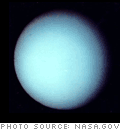Uranus

 |
Uranus, the first planet discovered in modern times by Sir William Herschel in 1781, is the seventh planet from the Sun, twice as far out as Saturn. Its mean distance from the Sun is 1,783 million miles (2,869 million kilometers). Uranus's equatorial diameter is 32,200 mi (51,810 km). The axis of Uranus is tilted at 97°, so it goes around the Sun nearly lying on its side.
Due to Uranus's unusual inclination, the polar regions receive more sunlight than its equatorial region during a Uranus year (equivalent to 84 Earth years). Scientists had thought that the temperature of its poles would be warmer than that at its equator, but Voyager 2 discovered that the equatorial temperatures were similar to the temperatures at the poles, –344°F (–209°C), implying that some redistribution of heat toward the equatorial region must occur within the atmosphere. The wind patterns on Uranus are much like Saturn's, flowing parallel to the equator in the direction of the planet's rotation.
Ninety-eight percent of the upper atmosphere is composed of hydrogen and helium; the remaining 2% is methane. Scientists speculate that the bulk of the lower atmosphere is composed of water (perhaps as much as 50%), methane, and ammonia. Methane is responsible for Uranus's blue-green color because it selectively absorbs red sunlight and condenses to form clouds of ice crystals in the cooler, higher regions of Uranus's atmosphere.
It was also discovered that the planet's magnetic field is 60° tilted from the planet's axis of rotation and offset from the planet's center by one-third of Uranus's radius. It may be generated at a depth where water is under sufficient pressure to be electrically conductive.
Uranus can—on rare occasions—become bright enough to be seen with the naked eye, if one knows exactly where to look; normally, a good set of field glasses or a small portable telescope is required.







